Four non-boring tummy-friendly recipes
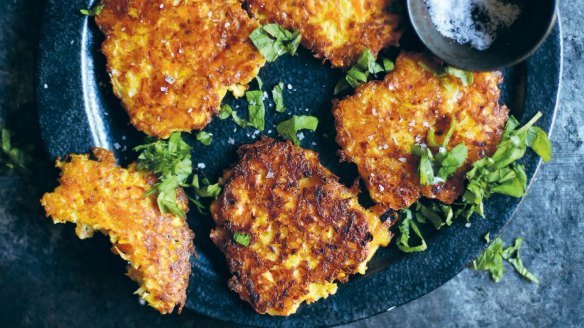
Four delicious yet easy-to-digest recipes from Melbourne food writer and photographer Georgia McDermott's new book FODMAP Friendly (Macmillan Australia, $34.99).
Carrot, parsnip and parmesan latkes recipe
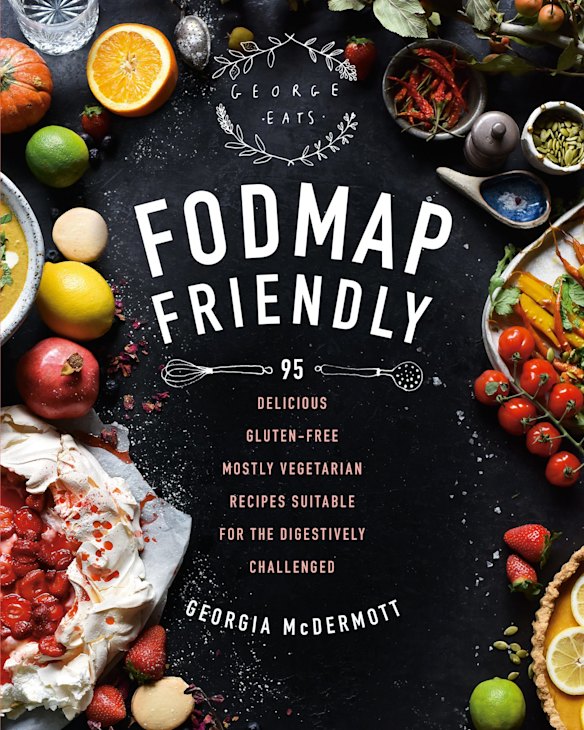
These latkes taste a lot like cheesy hash browns, which is entirely why I'm so fond of them. Although the traditional variety are made with potato, I've used carrot and parsnip, two lesser worshipped, but equally delicious FODMAP-friendly vegetables. These latkes are free of gluten, grains and nuts, low in lactose and suitable for almost all dietary requirements.
Makes 6 latkes (serves 2-3 people)
INGREDIENTS
100g parsnips
100g carrots
1 teaspoon table salt
75g parmesan, freshly grated
1 egg
cracked black pepper
neutral-tasting oil with a high smoke point (I use vegetable oil)
1 tablespoon roughly chopped soft herbs (dill or mint work well)
fried eggs to serve on top (optional)
METHOD
1. Grate the parsnips and carrots on the coarse side of your grater, then scoop the grated vegetables into a muslin cloth, nut-milk bag or a clean, non-white tea towel. Sprinkle with the salt and allow to sit over the sink in a colander for 10 minutes. Using considerable force, wring the water out of the vegetables, and then transfer to a medium bowl.
2. Add the grated parmesan and the egg, and mix thoroughly until a sort of batter has formed. Add a good sprinkle of pepper, and the herbs, if you are using them.
3. Heat a non-stick frying pan over a medium-high heat and add enough of a neutral-tasting oil to completely cover the base of the pan. Allow the oil to heat up thoroughly before adding a tablespoon or two of the latke mixture. Use the back of a spoon to press it down firmly and create a thin latke, about the size of your palm. Cook for a few minutes before gently flipping. The latke should be golden brown and crunchy on the outside.
4. Repeat with the remaining mixture and serve the latkes on their own, or topped with a fried egg and herbs scattered over.
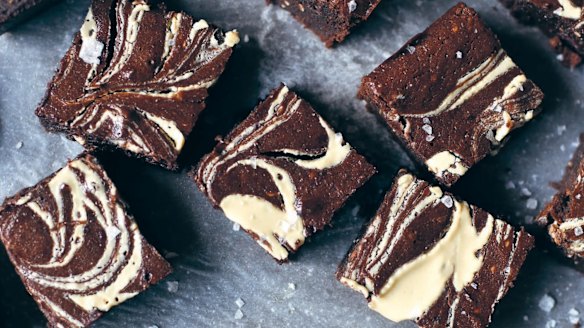
Sesame tahini brownies recipe
These don't have as much sugar as some traditional brownies, but they're given added interest by the sesame and tahini flavour. Tahini is FODMAP friendly at 1½ tablespoons per serve, and sesame seeds at less than 6 tablespoons, so unless you plan on eating 16 brownies, you're in the clear. Toasting the sesame seeds gives them a beautiful nutty flavour, but if you don't feel like milling them into a flour (which I do in my food processor) they work in their whole form as well.
Makes 16
INGREDIENTS
150g dark chocolate, roughly chopped
150g butter, plus extra for greasing
3 tablespoons tahini (plus an extra tablespoon, to decorate, if desired)
4 tablespoons freshly made espresso, optional
sea salt, optional
¼ cup fine white rice flour
1 tablespoon tapioca flour
3 tablespoons toasted sesame flour
30g (¼ cup) cocoa powder
100g (½ cup) white sugar
40g (¼ cup) light brown sugar
4 eggs
METHOD
1. Preheat the oven to 180°C. Grease a 20cm square baking tin with butter then line with baking paper, leaving excess paper hanging out to create little handles.
2. Put the chocolate, butter and tahini (and the espresso and a generous pinch of sea salt, if using) in a heatproof bowl. Place the bowl over a small saucepan half-filled with water and set over a medium heat, making sure the water doesn't touch the base of the bowl. Stir intermittently until the ingredients are completely combined. Remove from the heat and sift in the dry ingredients, stirring well to combine.
3. Mix in the eggs, one by one, until the mixture becomes a glossy, amorphous chocolate batter. Pour into the greased baking tin. If you're into it, spoon the extra tablespoon of tahini over the top and use a knife or skewer to create swirls on the surface.
4. Cook for 15-25 minutes: 15 minutes will leave the brownies extremely squidgy in the bottom, which is perfect if you plan to refrigerate them before serving; 25 minutes will result in completely firm, cake-like brownies. Once done to your liking, gently slice into small pieces (they're quite rich, so I slice them into 16), sprinkle with sea salt (if using) and serve.
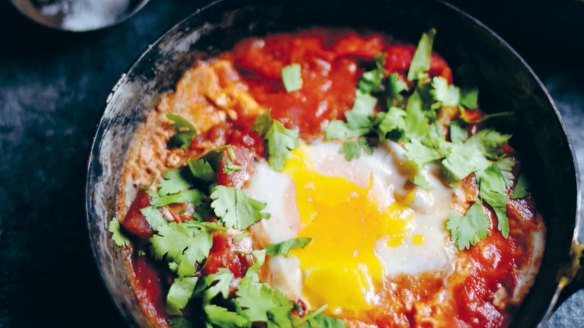
Roasted capsicum and haloumi shakshuka recipe
Given that the volume of onion and garlic in a standard cafe shakshuka could put me in bed for a week, I've given up ordering baked eggs when I'm out in favour of making them at home. Although they're a little labour intensive, roasted capsicums are a great substitute for the sweetness of caramelised onion, and anything that includes haloumi warrants a bit of extra elbow grease, as far as I'm concerned.
Serves 4
INGREDIENTS
4 medium-large red capsicums
2 tablespoons olive oil
1kg tomatoes, chopped
2 teaspoons ground cumin
1 teaspoon mixed spice
1 teaspoon garam masala
2 teaspoons light brown sugar
1 teaspoon harissa paste or chilli sauce (make sure
it doesn't contain onion or garlic)
1 teaspoon tomato paste
¼ piece preserved lemon rind
125g haloumi, diced
1 small handful each of fresh mint and coriander leaves, or your preferred herb
juice of ½ lemon
4 eggs
METHOD
1. Preheat the oven to 180°C and line a baking tray with baking paper.
2. Slice the capsicums in half, remove the seeds and lay them face down on the baking tray. Cook for at least 30 minutes, or until the flesh is soft and the skin has blistered and blackened. Once cooked, transfer them to a large bowl and cover with a cloth, to encourage them to sweat their skins off (aka what happens to me whenever the temperature reaches 26 degrees or higher).
3. Add the olive oil and tomatoes to a cast-iron frying pan over a medium heat (or you can use four small pans if you have them). Adding water as you see fit, cook the tomatoes down until they have the consistency of pasta sauce. Add the spices, sugar, harissa, tomato paste and preserved lemon, and gently stir to combine. Finally, add the haloumi cubes, herbs and the lemon juice, and stir gently to disperse throughout the mixture.
4. Using the back of a spoon, create a little indent for each egg, and gently crack each one into its designated spot. Turn the heat down to low, and cook extremely gently for a few minutes, alternating between placing a lid on and taking it off. Once the whites are cooked and the yolks still slightly runny, remove the pan from the heat and top with herbs and additional seasoning.
5. Allow to sit for a couple of minutes, so your guests don't burn their hands on the pan, or their mouths on the shakshuka.
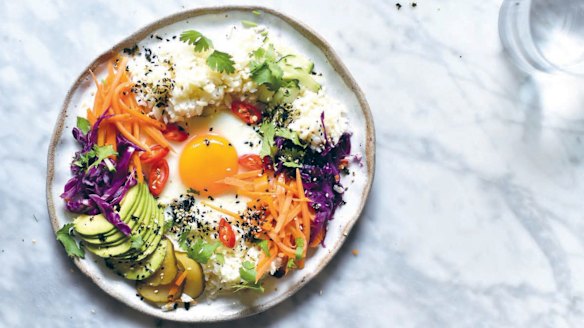
Coconut rice bibimbap recipe
When people reference the finer things in life, I'm reasonably certain they're talking about coconut rice. I derive an untold level of happiness from eating a plain bowl of the stuff, but here, I've paired it with bibimbap-inspired toppings, in turn inspired by a pastel-coloured brunch spot in New York called Cafe Henrie.
Serves 4
INGREDIENTS
Coconut rice
200g (1 cup) jasmine rice
375ml (1½ cups) water
250ml (1 cup) coconut milk
2 kaffir lime leaves (optional)
Quick or slow pickles (fills a large glass jar)
125ml (½ cup) rice
wine vinegar
125ml (½ cup) apple
cider vinegar
25g (¼ cup) light brown sugar
3 star anise
½ teaspoon cloves
2 bay leaves
5-10g of finely grated ginger
1-2 teaspoons sea salt
300g carrots, sliced into thin batons
300g cucumbers, thinly sliced
Must-have toppings
1 ripe avocado, halved, stoned, peeled and finely sliced
4 eggs
fresh carrot, cucumber and red cabbage (or other low-FODMAP veg of your choice)
furikake
sauerkraut (red cabbage sauerkraut is lower in FODMAPs than the white cabbage version)
Optional toppings
fresh coriander leaves,
finely sliced
fresh red chilli, finely sliced
METHOD
1. Add the rice to a large saucepan with the water and the coconut milk. Place the saucepan over a medium heat and cook for around 15-20 minutes, or until the rice has absorbed the majority of the liquid, stirring intermittently to ensure it isn't sticking to the bottom of the pan. Once the liquid has almost completely absorbed, take the saucepan off the heat and place a lid on it. Allow it to stand for around 15-20 minutes - it will still be warm, but in this time it will absorb the remaining liquid.
2. While you wait, add all the ingredients for the pickles (except the vegetables) plus 250ml (1 cup) water to a medium saucepan. Cook over a medium heat until the sugar has dissolved (around 5-10 minutes) and then add the carrot batons. Cook for an additional 5-10 minutes, or until the carrot starts to soften. Finally, add the cucumber slices and cook for an additional minute or so, until they too begin to soften. Once done, remove from the heat. The longer you allow the pickles to pickle, if you will, the more delicious they will be. I transfer mine to a sterilised glass jar, allow them to cool and then put them in the fridge, where they can be kept for months.
3. While you wait for the pickles, slice your chosen vegetable toppings, ready for assembly.
4. Lastly, fry the eggs to your liking in a little peanut or coconut oil.
5. To assemble, place a fried egg in the middle of the plate, and surround with rice, pickled vegetables, avocado slices, chopped fresh vegetables, furikake, sauerkraut and chilli and coriander (if using). Serve immediately.
This is an edited extract from FODMAP Friendly by Georgia McDermott, Macmillan Australia, $34.99.